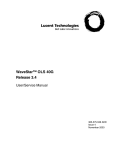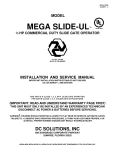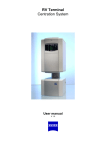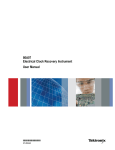Download Nortel Networks NTNM13XKAB User's Manual
Transcript
NTNM13XKAB INM Products Integrated Network Management Network Wide Backup & Restore Planning Guide Standard Rel 1.0 July 1999 Update issue: 2 July 1999 What’s inside... Network Wide Backup & Restore Description Network Wide Backup & Restore Compatibilities Network Wide Backup & Restore Engineering Considerations Network Wide Backup & Restore Requirements TCP/IP Network Requirements Copyright 1999 Nortel Networks, All Rights Reserved. The information contained herein is the property of Nortel Networks and is strictly confidential. Except as expressly authorized in writing by Nortel Networks, the holder shall keep all information contained herein confidential, shall disclose it only to its employees with a need to know, and shall protect it, in whole or in part, from disclosure and dissemination to third parties with the same degree of care it uses to protect its own confidential information, but with no less than reasonable care. Except as expressly authorized in writing by Nortel Networks, the holder is granted no rights to use the information contained herein. *Nortel Networks, the Nortel Networks logo, the Globemark, How the World Shares Ideas, Unified Networks, S/DMS TransportNode, S/DMS AccessNode, SONET Radio 4/40, and DMS are trademarks of Nortel Networks. ORBIX is a trademark of IONA Technologies. UNIX is a trademark of X/Open Company Limited. HP and HP-UX are trademarks of Hewlett-Packard, Inc. Printed in Canada iii Publication history 0 July 1999 Oficial release, for GA load, of Network Wide Backup & Restore Planning Guide, Rel 1.0, update 0.2. June 1999 Oficial release of Network Wide Backup & Restore Planning Guide, Rel 1.0, update 0.1. May 1999 Draft release for internal review of Network Wide Backup & Restore Planning Guide, Rel 1.0. Network Wide Backup & Restore Planning Guide Rel 1.0 Standard July 1999 iv Publication history Integrated Network Management Rel 1.0 Standard July 1999 v Contents 0 About this document vii Network Wide Backup & Restore Description 1-1 Graphical User Interface (GUI) 1-2 Controller List 1-2 Controller List Filtering/Sorting 1-3 Refreshing View 1-4 User Preferences Tab 1-5 Print & Export Tab 1-6 History Tab 1-7 Recurring/Custom Storage Location 1-7 Details Window Description 1-8 Controllers Tab 1-8 Restore Tab 1-11 Restore Action 1-11 Recurring/Custom Storage Location 1-11 Stored Backup Window Description 1-11 Details Window description 1-12 Recurring Backup Tab 1-12 One Time Backup Tab 1-14 Network Wide Backup & Restore Compatibilities 2-1 GUI compatibilities 2-1 Network Wide Backup & Restore Engineering Considerations 3-1 Network Wide Backup & Restore Engineering Rules 3-1 Engineering Capacities 3-1 Disk Space Requirements 3-1 Estimated Time to Backup an OPC 3-2 Estimated Time to Backup an NP 3-2 Additional Capacities 3-2 Network Wide Backup & Restore Requirements 4-1 Hardware Requirements 4-1 Operating System Requirements 4-1 First Time Installation 4-1 Network Wide Backup & Restore Planning Guide Rel 1.0 Standard July 1999 vi Contents TCP/IP Network Requirements 5-1 Ethernet 5-1 TCP/IP 5-2 LAN requirements 5-2 X.25 5-2 WAN requirements 5-3 Summary 5-4 List of terms Integrated Network Management 6-1 Rel 1.0 Standard July 1999 vii About this document 0 This document describes the Network Wide Backup & Restore supported by INM. Network Wide Backup & Restore is a software application that allows customer to manage network wide controller backups, which can be used to aid in network restoration after catastrophic hardware failure. This software application provides the ability to centralize and automate backup of Network Element database and Subnetwork Controller configuration data onto an INM server. Audience for this document This planning guide is for the following audience: • strategic and current planners • provisioners • transmission standards engineers • network administrators References This document references the following Nortel Networks technical publications (NTP) and other documentation: • INM Planning Guide, PG OC 98-15 • INM Installation and Administration User Guide, 450-3101-201 • Network Wide Backup & Restore User Guide, 450-3101-031 Technical support and information Nortel Networks maintains Integrated Network Management (INM) support centers in North America and the United Kingdom (UK). Based on the location from which your account is managed, refer to one of the following sections. Network Wide Backup & Restore Planning Guide Rel 1.0 Standard July 1999 viii About this document Customer accounts managed in North America INM Customer Care provides technical support for INM customer accounts managed in North America. The support provided consists of emergency and regular technical support and an INM Product Services suite of additional support services. Use one of the following telephone numbers to reach INM Customer Care. If you are in Canada or the US Call toll free: 1-877-684-6622 (1-877-NTINMCC) If you are not in Canada or the US Call: 1 (country code) 613-765-7766 Emergency technical support You can reach emergency technical support personnel outside of the regular technical support hours through an automatic paging system. Nortel Networks provides emergency technical support for INM customers who have purchased an optional, value-added service package. The service package provides technical support outside of regular hours for critical issues for the period covered by the service package. Note: Access to regular technical support for all issues defined in the service package is also available for the period covered by the service package. Issues considered critical include: • issues that are now having an effect on, or have the potential to immediately have an effect on, services carried by the managed nodes • issues causing the loss of network visibility or loss of fault management functionality to one or more of the managed nodes Regular technical support Nortel Networks provides regular technical support for INM customers who have purchased an optional, value-added service package. Call INM Customer Care: • Monday to Friday • 08:00 to 20:00 hrs • eastern standard time (EST) or eastern daylight time (EDT) Use the regular technical support to report and receive help for issues covered by the product warranty, as described in your purchase agreement with Nortel Networks. Integrated Network Management Rel 1.0 Standard July 1999 About this document ix You can be charged a standard rate for service requests that Nortel Networks considers to be outside the scope or period covered by the product warranty. You can purchase extended warranty coverage and additional support services. These optional, value-added service packages are part of the INM Product Services suite. INM Product Services A full suite of optional, value-added services and service packages is available for purchase through the INM Product Services suite. The services include: • extended product warranty support • advanced technical support • installation planning and support • on-site installation • technical training • software upgrades • extended HP warranty • network planning and integration consultation • Network Management System Audits and Performance Reports Contact your Nortel Networks representative for more information about the INM Product Services suite. Customer accounts managed in the United Kingdom The Nortel Networks Service Desk provides technical support for INM customer accounts managed in the UK. You can reach the Service Desk from Monday to Friday between 08:30 and 17:00 (UK local time) using the following FAX or telephone numbers: If you are in the United Kingdom Freephone: 0800 626 881 Telephone: 0208 361 4693 FAX: 0208 945 3456 If you are not in the United Kingdom Telephone: +44 208 361 4693 FAX: +44 208 945 3456 Network Wide Backup & Restore Planning Guide Rel 1.0 Standard July 1999 x About this document EMC conformance This product/product family complies with the provisions of the Low Voltage Directive 73/23/EEC, and with the essential protection requirements of the EMC Directive 89/336/EEC as amended by 92/31/EEC, when it is properly installed and maintained and when it is used for the purposes for which it is intended. Integrated Network Management Rel 1.0 Standard July 1999 1 1-1 Network Wide Backup & Restore Description 1- Network Wide Backup & Restore centralizes controller backup administration and storage by allowing all backup related activities to be managed at the INM platform. The Network Wide Backup & Restore Release 1.0 features are listed below: • Administration and Maintenance of all controller backups from 1 common graphical user interface on the INM platform. • A centralized disk oriented storage solution for maintaining backups that is more reliable than remote tape archives. There is no longer a need to travel to remote controllers to collect backup tape archives. • Ability to set the bandwidth consumption for the transfer of the remote backup to INM on an individual controller basis (OPCs only). • Ability to schedule both recurring and one time backups on an individual controller basis. • Ability to specify the storage disk used on an individual controller basis. • Ability to maintain a specified number of backups before overwriting older backups (FIFO - First In, First Out) • Ability to “lock” a specified backup. If a controller’s configuration is very stable, and a certain backup has been tested, the customer might not want to have that backup overwritten by other scheduled backups. All other backups for that controller would continue to run, but would not overwrite this version. This would still allow for backups of some minor provisioning changes which might occur. • Ability to support 2 levels of users: NOCADM for making schedule changes and READ ONLY for all others. Each installation of INM Backup & Restore can concurrently support a maximum of 1 NOCADM UI. • Ability to initiate a restore, which transfers archived files back to the remote controller. • Ability to support 150 controllers from each INM Backup & Restore installation where a controller can be an OPC, NP, or an EC1 MOA. Network Wide Backup & Restore Planning Guide Rel 1.0 Standard July 1999 7 10 1-2 Network Wide Backup & Restore Description • Ability to print summaries of controllers being managed in both a readable, and comma separated value format. Graphical User Interface (GUI) The Network Wide Backup & Restore application is launched as a separate process from the GNB’s Configuration menu. Controller List This window contains information that the Backup & Restore application possesses about the controllers (refer to Figure 1-1). This controller list is used as the source of information for many of the tabs (History, Controllers, Restore, Recurring Backup, One Time Backup). The information that it contains is listed in Table 1-1. Table 1-1 Controller information Column Description Name contains the name of the particular controller IP Address contains the IP address of the controller Port contains the Port of the controller (if any) State contains the state of the controller with respect to Backup & Restore Ctrl Type indicates the type of the controller Recurring Backup indicates the date and time of the next recurring backup (if any) One-Time Backup indicates the date and time of the scheduled one-time backup (if any) Integrated Network Management Rel 1.0 Standard July 1999 Network Wide Backup & Restore Description 1-3 1 Figure 1-1 Controller List window 7 Controller List Filtering/Sorting This feature allows users to customize the controller list according to the options that are chosen. Network Wide Backup & Restore Planning Guide Rel 1.0 Standard July 1999 10 1-4 Network Wide Backup & Restore Description The list is filtered by selecting the checkboxes that appear at the top of the controller list. The default is “All”, by de-selecting all and selecting the desired controllers, a list of controllers that fall into those contraints will be displayed. For example, if OPC and NPC were selected, then the controller list will display the controllers of type OPC and type NPC, complying to the constraints. It is possible to filter the table a controller type that does not appear as a checkbox, this is done through the “Other” checkbox and the selectable drop down window that appears. The list is sorted by clicking on the column heading that you wish to be sorted. Sorting can be done in ascending or descending order. To sort in ascending order merely click on the column heading in which you want to use as your key, to sort in descending order click on the heading again. Sorting can be done on any of the 7 columns found in the controller list window in the same fashion. Refreshing View The view that is displayed is a static view, correct to the time that is displayed, therefore to obtain a newer instance of the controller list and information you must click on the “Refresh” button. This will import a new instance of the controller list, correct to the date and time displayed on “Last Refresh” line. Integrated Network Management Rel 1.0 Standard July 1999 Network Wide Backup & Restore Description 1-5 1 User Preferences Tab Figure 1-2 User Preferences tab Under the User Preferences tab will be the following preference setting options: 7 Table 1-2 Preference setting options Label Input Widget values Default Description Log Level: option menu 1-5 1 Amount of detail to add to the log file. Print command: text entry widget max 80 char NULL For the Print & Export tab Concurrent Jobs: option menu 1-5 1 Number of concurrent ftp backup sessions possible Email notification radio button of Errors YES/NO YES/NO NO Should errors be emailed to addresses below. Email error messages to: max 80 char NULL Any errors will notify these email addresses (comma separated). (80 characters max) text entry widget —continued— Network Wide Backup & Restore Planning Guide Rel 1.0 Standard July 1999 10 1-6 Network Wide Backup & Restore Description Table 1-2 (continued) Preference setting options Label Input Widget values Default Describe Controllers as option menu IP:Port, IP:Port IP:Port Name, Name How to describe controller in error/log messages. Managed Error States text entry widget max 80 char Describes States errors can be set to in the “Manage Errors” Tab. new Description Print & Export Tab Figure 1-3 Print & Export tab Under the Print & Export Tab should be the following radio button options: • CSV Controller Data with Header • CSV Controller Data without Header • Readable Controller Data • INM vs. Backup & Restore OPC List • Managed Errors Integrated Network Management Rel 1.0 Standard July 1999 Network Wide Backup & Restore Description 1-7 1 The user would first select from the above radio buttons. The user next would select between “Printer” and “File” radio buttons (one must always be selected). If selecting “Printer”, the UI first defaults to the print command defined in the Preferences tab, but it can be changed. For “File”, the user must define an export file. History Tab The History Tab provides detailed information on the backups stored for a particular controller. It also provides for administration of these backup files. In addition, detailed information about a specific backup, such as the software load and the scheduled backup date, is viewable. This tab contains features in which a backup for a selected controller can be deleted, locked, or unlocked. Figure 1-4 History tab 7 10 Recurring/Custom Storage Location It is possible to have backups that are located somewhere other than the default location as defined in the “Recurring Backup” tab. To facilitate this possibility, the user of Backup & Restore will be able to specify a different location to look for controller backups. The default of this tab is to view the backups that are Network Wide Backup & Restore Planning Guide Rel 1.0 Standard July 1999 1-8 Network Wide Backup & Restore Description located in the “Storage Location” defined in the “Recurring Backup” tab. To choose a custom storage Location, select the Custom Storage Location radio button and type in the directory where the backups reside. Alternatively, once the Custom Storage Location Radio Button is selected, the Browse button can be used to locate the repository for the backups desired. After the appropriate location is chosen, selecting the “OK” button, the information pertaining to these files will be filled into the tables. Details Window Description The Details window contains information for a particular backup. Once a backup is selected, the Details table will indicate any related data that has been sent by the controller at the time the backup was created. The following data is mandatory and is passed from the controller to the Backup & Restore application: • Controller Type • Controller Name, IP Address • Name of Controller Software Load • Backup Date (from controller) • Backup Date (timestamp developed by INM) The controller can also pass other information which will be presented in this window. Controllers Tab The Controllers tab enables the addition/deletion of a controller to the tool’s list of managed controllers. Integrated Network Management Rel 1.0 Standard July 1999 Network Wide Backup & Restore Description 1-9 1 The Controller Tab screen contains crucial information pertaining to the Controller in question, such as the IP, MOA IP, etc. Using this component of the Backup & Restore, the controllers can be added or deleted to and from the controllers list, respectively. 7 Figure 1-5 Controllers tab Table 1-3 Controller tab information Item Description Valid Inputs Controller Type The controller type field enables the selection of a controller from a list of pre-determined controllers. The valid inputs for this structure is a selection from the drop down menu. Name Name is the unique identifier that will distinctly distinguish each controller from another. IP The address in which the controller is occupying within the network. A valid IP address for the network in question. Port If the selected controller needs a specific port in which it can be reached, then it is entered here. A valid port that exists on the selected controller. MOA IP The IP of the MOA that is managing the connectivity The IP address of the MOA. to the network elements. —continued— Network Wide Backup & Restore Planning Guide Rel 1.0 Standard July 1999 10 1-10 Network Wide Backup & Restore Description Table 1-3 (continued) Controller tab information Add new controller This is selected if a new controller is added to the N/A network. This disables the delete feature of Save & Restore. Delete selected controller By choosing Delete selected controller, the information of the selected controller will then appear in the appropriate boxes. N/A Save Save makes permanent all the changes that have occurred. N/A Delete Delete erases the controller for the controller list N/A Integrated Network Management Rel 1.0 Standard July 1999 Network Wide Backup & Restore Description 1-11 1 Restore Tab Figure 1-6 Restore tab 7 Restore Action After selecting a backup to restore in the “Stored Backup Window”, selecting “Restore” will start an ftp download of the file to the controller. After the download is initiated, it can be cancelled at any time using the “Cancel” button located in the Controller Status Tab. The “Cancel Restore” button will only be enabled after a restore has started. It is only possible to restore 1 controller at a time, Once a restore has commenced, the “Restore” button for all controller will be disabled. Recurring/Custom Storage Location For description, see section “Recurring/Custom Storage Location” of the History Tab. Stored Backup Window Description For description, see section “Stored Backup Window” of the History Tab. Network Wide Backup & Restore Planning Guide Rel 1.0 Standard July 1999 10 1-12 Network Wide Backup & Restore Description Details Window description For description, see section “Details Window” of the History Tab. Recurring Backup Tab The recurring backup tab contains the information pertaining to the controller's time and storage location of the backups. Using this tab, time and storage location can be entered for Backup & Restore to perform a backup on a recursive basis. Figure 1-7 Recurring Backup tab Setting a recurring backup time To set up a recurring backup time for a particular controller, select the controller and the Recurring Backup tab and by adjusting the controller's recurring attributes. The following table lays out the field type, description, and valid input. Table 1-4 Setting a recurring backup time information Field Description Valid Input YYYY Four digit calendar year. XXXX where XXXX denotes an integer form of year. MM Two digit calendar month. XX-- where XX denotes an integer between 01 - 12 inclusive. Start Date Integrated Network Management Rel 1.0 Standard July 1999 Network Wide Backup & Restore Description 1-13 1 Table 1-4 (continued) Setting a recurring backup time information DD Two digit calendar day. XX -- where XX denotes an integer between 01 - 31 inclusive. HH Two digit representation of hour on a 24 hour clock. XX -- where XX denotes an integer between 00-23 inclusive. MM Two digit representation of minutes. XX -- where XX denotes an integer between 00 - 59 inclusive. SS Two digit representation of seconds. XX -- where XX denotes an integer between 00 - 59 inclusive. Start Time Backup Every Integer accompanied by the portion of date that the integer represents. Integer; accompanied by Weeks, Days, or Hours from the drop down menu. OPC pacing speed Packet size of the backup. Drop down menu. Number to Keep The number of desired backups kept as archived backups. Integer; falling between 1 - 9. Storage Location The exact path to the storage location of the backup. Path to directory on a UNIX NFS. Save Saving the dates, time, storage location, etc. of a recurring backup for a particular controller is done by entering the information into the appropriate form boxes and pressing the "Save" button. If there is a type error, where the information that is entered is not valid, a error dialog will pop up and alert you to such. If all the information is of a logical type, then the UI will perform the addition or modification of the recurring backup for the selected controller. 7 To delete a recurring backup, clear the fields using the “Clear” button and save the information. Clear/Set To Defaults/Save As Defaults These three actions refer to the content that is filled in the Start date, time, pacing speed, and storage location. “Clear” clears all the information. It does not delete the information from the scheduler. “Set To Defaults” action button loads default information stored by the UI into the corresponding textboxes. After the information is loaded from the data store, it is still possible to change/alter the information in the text fields. Network Wide Backup & Restore Planning Guide Rel 1.0 Standard July 1999 10 1-14 Network Wide Backup & Restore Description “Save as Defaults” action button saves the current information in the data fields as the UI defaults for recurring backups. This is stored, and can be read in by the “Set To Defaults” action button. It is important to realize that this information should be generic enough to span the entire controller list, not just selected controllers. One Time Backup Tab Figure 1-8 One Time Backup tab The one time backup tab allows for a backup to take place on a controller which occurs only once. A one time backup might be performed before some upgrades, testing etc. Setting up a One Time Backup To set up a one time backup time for a particular controller, select the controller and the One-Time Backup tab. Then set the required fields. The following table lays out the field type, description, and valid input. Table 1-5 Setting up a One Time Backup information Field Description Valid Input YYYY Four digit calendar year. XXXX where XXXX denotes an integer form of year. MM Two digit calendar month. XX-- where XX denotes an integer between 01 - 12 inclusive. Start Date —continued— Integrated Network Management Rel 1.0 Standard July 1999 Network Wide Backup & Restore Description 1-15 1 Table 1-5 Setting up a One Time Backup information DD Two digit calendar day. XX -- where XX denotes an integer between 01 - 31 inclusive. Start Time HH Two digit representation of XX -- where XX denotes an integer between 00-23 inclusive. hour on a 24 hour clock. MM Two digit representation of XX -- where XX denotes an integer between 00 - 59 inclusive. minutes. SS Two digit representation of XX -- where XX denotes an integer between 00 - 59 inclusive. seconds. OPC pacing The packet size of the speed backup. Drop down menu. Storage Location Path to directory on a UNIX NFS. The exact path to the storage location of the backup. Save Action See description in “Recurring Backup” section. Clear/Set To Defaults/Save As Defaults See description in “Recurring Backup” section. 7 10 Network Wide Backup & Restore Planning Guide Rel 1.0 Standard July 1999 1-16 Network Wide Backup & Restore Description Integrated Network Management Rel 1.0 Standard July 1999 2 2-1 Network Wide Backup & Restore Compatibilities 2- Network Wide Backup & Restore Release 1.0 software is compatible with INM Release 5.0 and currently supports the S/DMS TransportNode product releases listed in Table 2-1. GUI compatibilities Table 2-1 lists the S/DMS TransportNode product releases required to obtain Network Wide Backup & Restore Release 1.0 functionality. Table 2-1 Controller release line-up Controller Release Data Backed Up OC12 Release 14.0 NE & OPC Databases, and misc. OPC files OC48 Release 15.0 NE & OPC Databases, and misc. OPC files OC192 Release 6.0 NE & OPC Databases, and misc. OPC files AccessNode Release 18.0 Planned NE & OPC Databases, and misc. OPC files OC3 Express HX - Release 5.0 CX - Release 4.0 JAPAN - Release 5.0 SP’s transport/provisioning data, PM Threshold Crossings TN-1P Release 2 NE & OPC Databases TN-1C Release 1, 2, 3 NE & OPC Databases TN-1X Release 7, 8 NE & OPC Databases TN-4XE Release 1, 2, 2.02, 3 NE & OPC Databases TN-64X Release 2 NE & OPC Databases Network Wide Backup & Restore Planning Guide 7 10 Rel 1.0 Standard July 1999 2-2 Network Wide Backup & Restore Compatibilities Integrated Network Management Rel 1.0 Standard July 1999 3-1 Network Wide Backup & Restore Engineering Considerations 3 3- Network Wide Backup & Restore Engineering Rules The Network Wide Backup & Restore engineering considerations for Release 1.0 are as follows: • Since Network Wide Backup & Restore application is coresident with INM Broadband Release 5.0, the minimal bandwidth for the WAN communication link is 56 Kbits/sec. The recommended bandwidth is 1.544 Mbits (DS1). • For an OPC connectivity to the INM and Backup & Restore workstation, the minimal recommended bandwidth for the communication link is 56 Kbits/sec. Engineering Capacities Disk Space Requirements 7 The disk space required to store controller backups is dependent on the following: • number of controllers • type of controllers • number of Network Elements which store data on the controller • number of backups maintained/controller Following formula can be used to estimate the amount of disk space required specifically for Network Wide Backup and Restore application. Disk_space_1 = (# of OPCs) * (5 MByte/OPC) * (# of backups to keep) Disk_space_2 = (# of NPs) * (1 MByte/NP) * (# of backups to keep) Disk_space_3 = (# of EC1 MOAs) * (TBD) * (# of backups to keep) Total_disk_space = Disk_space_1 + Disk_space_2 + Disk_space_3 Network Wide Backup & Restore Planning Guide Rel 1.0 Standard July 1999 10 3-2 Network Wide Backup & Restore Engineering Considerations Estimated Time to Backup an OPC The estimated time for OPC backup to complete is dependent on the following: • available bandwidth • number of controllers • concurrent jobs setting under the user preferences of the GUI Table 3-1 Estiimated time to backup an OPC # of OPC 56kb/s Conc_Job=1 56 kb/s Conc_Job=5 1.544 mb/s (T1) Conc_Job=1 1.544 mb/s (T1) Conc_Job=5 1 27 minutes 27 minutes 17 minutes 17 minutes 10 135 minutes 45 minutes 27 minutes 25 minutes 50 615 minutes 165 minutes 115 minutes 65 minutes 150 1815 minutes 465 minutes 315 minutes 165 minutes Estimated Time to Backup an NP The estimated time for NP backup to complete is dependent on the following: • # of NPs on the same MOA • available bandwidth • number of NPs Table 3-2 Estimated time to backup an NP # of NP 56 kb/s 1.544 mb/s (T1) 1 7 minutes 4 minutes 10 70 minutes 40 minutes 50 350 minutes 20 minutes 150 1050 minutes 600 minutes Additional Capacities The following table shows the engineering capacities for the backup and restore GUI usage, as well the number of simultaneous backups and restores allowed. Integrated Network Management Rel 1.0 Standard July 1999 Network Wide Backup & Restore Engineering Considerations 3-3 Table 3-3 Network Wide Backup & Restore capacities Description INM Broadband Release 5.0 HP Workstation Model C360 Number of instances of the Backup and Restore GUI with Admin priviledges 1 Number of instances of the Backup and Restore GUI with View only priviledges 3 Number of simultaneous backups 5 Number of simultaneous restores 1 Number of controllers that can be added in Backup and Restore’s Controllers List 150 3 7 10 Network Wide Backup & Restore Planning Guide Rel 1.0 Standard July 1999 3-4 Network Wide Backup & Restore Engineering Considerations Integrated Network Management Rel 1.0 Standard July 1999 4-1 Network Wide Backup & Restore Requirements 4- This section references the various requirements, both hardware and software, necessary to support the Network Wide Backup & Restore Release 1.0 software. 4 Hardware Requirements Since Network Wide Backup & Restore software has to be coresident with INM Release 5.0, the recommneded hardware platforms of choice are described in INM Release 5.0 Planning Guide under the section “INM Release 5.0 Requirements”. Operating System Requirements HP workstations must run HP-UX Release 10.20 ACE, and HP-VUE 3.0 to support Network Wide Backup & Restore. 7 Again since Network Wide Backup & Restore software is coresident with INM Release 5.0, refer to INM 5.0 Planning Guide for detailed information on operating system requirements and HP-UX 10.20 software patches. First Time Installation If the workstation is purchased from Northern Telecom (Nortel), the HP-UX operating system is installed and configured. However, the following tasks must be performed before installing the software: • Connect the workstation to the local area network (LAN). • Configure HP-UX 10.20 ACE according to the requirements for INM Release 5.0 (refer to HP-UX System Administration Tasks manual for this procedure). • Modify the HP-UX kernel parameters as required (refer to HP-UX System Administration Tasks manual for this procedure). This procedure verifies the setup of the HP-UX kernel parameters described in INM 5.0 Planning Guide. Network Wide Backup & Restore Planning Guide Rel 1.0 Standard July 1999 10 4-2 Network Wide Backup & Restore Requirements • • Install the INM 5.0 Core software prior to the Backup & Restore software. Refer to chapter 1, “Getting Started”, and chapter 2, “Installing the INM software”, in INM 5.0 User Guide Install the Network Wide Backup & Restore software. Refer to chapter 2, “Installation of Network Wide Backup and Restore”, in Network Wide Backup & Restore User Guide. Integrated Network Management Rel 1.0 Standard July 1999 5-1 TCP/IP Network Requirements 5- This section provides a general description of ethernet networks, TCP/IP and X.25 protocols and the requirements needed to support the operation of the Network Wide Backup and Restore application with INM Broadband. Ethernet The ethernet protocol is a standard defined by the Institute of Electrical and Electronics Engineers (IEEE) for communication networks. The IEEE standard 802.3 defines the layer 2 functionality in the protocol stack shown below. 5 Figure 5-1 OSI 7 Layer Protocol Stack NM-00014(R5) 7 Application 6 Presentation 5 Session 4 Transport 3 Network 2 Data Link 1 Physical 7 The characteristics of a 10-Base-T Ethernet network are: • Maximum speed of 10 Mbits/sec • Maximum number of 100 Ethernet devices per network • Carrier Sense Multiple Access with Collision Detection (CSMA/CD) media access control Network Wide Backup & Restore Planning Guide Rel 1.0 Standard July 1999 10 5-2 TCP/IP Network Requirements TCP/IP The TCP/IP acronym stands for Transport Control Protocol/Internet Protocol. These protocols are implemented in the protocol stack as shown in Figure 5-1 on page 1. This protocol is commonly used in conjunction with ethernet networks. The TCP/IP address, also known as the IP address, is used to uniquely identify each ethernet device on a network. This address is of the form: nnn.nnn.nnn.nnn where nnn is a number from 0 to 255 (i.e., 47.246.0.71). This address is normally assigned by the LAN administrator in order to prevent address conflicts between ethernet devices. For more information please see Mark A. Miller, Internetworking: A Guide to Network Communications, MT&T Books, 1991. LAN requirements The definition of a Local Area Network (LAN) is a network supporting peer-to-peer communication over distances of tens of meters to several kilometers. The LAN requirements for the INM Broadband are: • Connectivity to the INM workstation • Ethernet connections between the INM Broadband and the X Terminals • Router or bridge access to remote OPC modules through a WAN • Ethernet connection between local OPCs and INM Broadband Routers are usually stand-alone devices which provide the capability to interface to many different types of networks, as well as to determine the optimal path to the destination. Routers are commonly used to bridge remote LANs through a WAN and can provide access to X.25, T1, frame relay, and other types of network. The router for the INM Broadband must be capable of supporting a minimum bandwidth of 56 Kbit/s for a setup consisting of the INM Broadband and two X Terminals. The routers for the OPC modules must have a minimum bandwidth of 56 Kbit/s to support 6 user sessions each. The routers should be able to support both TCP/IP and OSI protocols for future applications. X.25 The X.25 protocol standard defines the interface to a Packet Data Network (PDN), or more specifically, it defines the Data Terminal Equipment (DTE) and Data Communications Equipment (DCE) interfaces between a synchronous packet-mode host and a PDN. The X.25 protocol suite does not, however, define the internal architecture of the PDN nor does it define the PDN’s operation. An X.25 data packet network is normally used in a wide area Integrated Network Management Rel 1.0 Standard July 1999 TCP/IP Network Requirements 5-3 network for data communications to remote sites. For more information please see Mark A. Miller, Internetworking: A Guide to Network Communications, MT&T Books, 1991. Figure 5-2 INM Broadband X.25 WAN Configuration PG-0005.1 LAN router with WAN (X.25) access LAN router with WAN (X.25) access 56 Kb/sec X.25 DCN 56 Kb/sec IEEE 802.3 S/DMS Network Manager 56 Kb/sec O P C 56 Kb/sec IEEE 802.3 IEEE 802.3 X terminal O P C 5 O P C O P C 7 IEEE 802.3 X terminal WAN requirements The requirement for the wide area network is to provide ports to the INM Broadband at 56 Kbit/s and to the OPC modules at 19.2 Kbit/s The definition of a Wide Area Network (WAN) is a network that ties together users or networks of users which are widely separated geographically. Typically, a WAN will use public or private telecommunications facilities, such as X.25 or T1, to provide the link between its users. If the primary functions of the INM Broadband are surveillance and provisioning, then X.25 or sub-DS0 line rates will be sufficient for the WAN, shown in Figure 5-2 on page 3. If the INM Broadband is to be used in a software delivery function, then sub-rate T1 or T1 links are recommended as shown in Figure 5-3 on page 4. Network Wide Backup & Restore Planning Guide Rel 1.0 Standard July 1999 10 5-4 TCP/IP Network Requirements Figure 5-3 INM Broadband Leased Line WAN Configuration PG-0005.1 LAN router with lease line capability 56 Kb/sec or higher IEEE 802.3 56 Kb/sec or higher S/DMS Network Manager IEEE 802.3 O P C 56 Kb/sec or higher O P C IEEE 802.3 X terminal O P C O P C IEEE 802.3 X terminal Summary Two approaches can be used to connect the INM Broadband to the OPC modules: • If the INM Broadband and the OPC modules are co-located, then a LAN only solution may be used • If the INM Broadband and all the OPC modules are not co-located, then a WAN solution must be used to supplement the LAN solution. Two different types of WANs can be used, X.25 and Leased Line. Integrated Network Management Rel 1.0 Standard July 1999 6-1 List of terms 6- ABM Access Bandwidth Manager ADM add-drop multiplexer alarm a signal which alerts staff to an equipment fault or problem AN 6 S/DMS AccessNode ASCII American Standard Code for Information Interchange balloon 7 a balloon-shaped object that appears on a node to indicate alarm counts BLSR bidirectional line switched ring CCITT Consultative Committee on International Telegraphy and Telephony. This committee has been replaced by the International Telecommunications Union (ITU) CLFI 10 Common Language facility identifier CMT character-mode terminal Network Wide Backup & Restore Planning Guide Rel 1.0 Standard July 1999 6-2 List of terms CNet control network CPC common product code CPG circuit pack group CSM centralized software management DARPA Defense Advanced Research Projects Agency DDS digital data storage (tape) DMS Digital Multiplex System DMS MAP Digital Multiplex System Maintenance Access Position DV45 Digital Video Codec EDA external device access ftp file transfer protocol GNB Graphical Network Browser GNE Graphical Network Editor group a logical collection of network elements Integrated Network Management Rel 1.0 Standard July 1999 List of terms 6-3 GUI graphical user interface highlighting the graphical application of color to a node to indicate a certain alarm severity HP Hewlett-Packard HP VUE Hewlett-Packard Visual User Environment indicator an audible or visible alert to an alarm or status condition ISO International Organization for Standardization ITU International Telecommunications Union. This committee replaces the Consultative Committee on International Telegraphy and Telephony (CCITT). 6 local area network 7 LAN log in the action of opening a user interface element log out the action of closing a user interface element LTE line terminating equipment MAPCI Maintenance and Administration Position Command Interpreter 10 menu a list of action options menu bar the portion of the graphical user interface that contains the status indicator, and the window menus Network Wide Backup & Restore Planning Guide Rel 1.0 Standard July 1999 6-4 List of terms MOA managed object agent, for example, an operations controller network element (NE) a collection of equipment at one location that functions and is administered as a single entity node graphic object representing groups or single network elements NTP Nortel Networks technical publication NUM Network Upgrade Manager, an OPC tool OAM&P operations, administration, maintenance, and provisioning OC-3 an optical carrier signal in the SONET optical format which is three times the OC-1 rate (OC-1 is an STS-1 signal translated into an optical signal) OC-12 an optical carrier signal in the SONET optical format which is 12 times the OC-1 rate (OC-1 is an STS-1 signal translated into an optical signal)) OC-48 an optical carrier signal in the SONET optical format which is 48 times the OC-1 rate (OC-1 is an STS-1 signal translated into an optical signal)) OC-192 an optical carrier signal in the SONET optical format which is 192 times the OC-1 rate (OC-1 is an STS-1 signal translated into an optical signal) OPC operations controller OSI Open Systems Interconnection PEC product engineering code Integrated Network Management Rel 1.0 Standard July 1999 List of terms 6-5 PM performance monitoring SAM System Administration Manager S/DMS Synchronous/Digital Multiplexing System SOC span of control SONET a standard for optical transport formulated by the Exchange Carriers Standards Association (ESCA) for the American National Standards Institute (ANSI). The standard defines optical carrier (OC) levels and their electrically equivalent synchronous transport signals (STS). span all network elements under the control of a single operations controller (OPC) 6 STS-1 synchronous transport signal level 1 (SONET, 51.84 Mbit/s) 7 subnetwork a graphical collection of objects organized into groups to represent the network elements monitored by INM Broadband. system network elements associated with the same payload TA-1230 ring Bellcore standard for SONET BLSR Equipment Criteria, TA-NWT-001230 (issue 2) TCP/IP Transmission Control Protocol/Internet Protocol 10 UDLC Universal Digital Loop Carrier UI user interface Network Wide Backup & Restore Planning Guide Rel 1.0 Standard July 1999 6-6 List of terms USM User Session Manager VTBM virtual tributary bandwidth management window a rectangular area of a display screen used to contain a particular application WAN wide area network X.25 CCITT protocol used for wide-area packet switching. OSI Data communication standard Integrated Network Management Rel 1.0 Standard July 1999 INM Products Integrated Network Management Network Wide Backup & Restore Planning Guide Copyright 1999 Nortel Networks, All Rights Reserved. The information contained herein is the property of Nortel Networks and is strictly confidential. Except as expressly authorized in writing by Nortel Networks, the holder shall keep all information contained herein confidential, shall disclose it only to its employees with a need to know, and shall protect it, in whole or in part, from disclosure and dissemination to third parties with the same degree of care it uses to protect its own confidential information, but with no less than reasonable care. Except as expressly authorized in writing by Nortel Networks, the holder is granted no rights to use the information contained herein. *Nortel Networks, the Nortel Networks logo, the Globemark, How the World Shares Ideas, Unified Networks, S/DMS TransportNode, S/DMS AccessNode, SONET Radio 4/40, and DMS are trademarks of Nortel Networks. ORBIX is a trademark of IONA Technologies. UNIX is a trademark of X/Open Company Limited. HP and HP-UX are trademarks of Hewlett-Packard, Inc. Standard Rel 1.0 July 1999 Printed in Canada























































